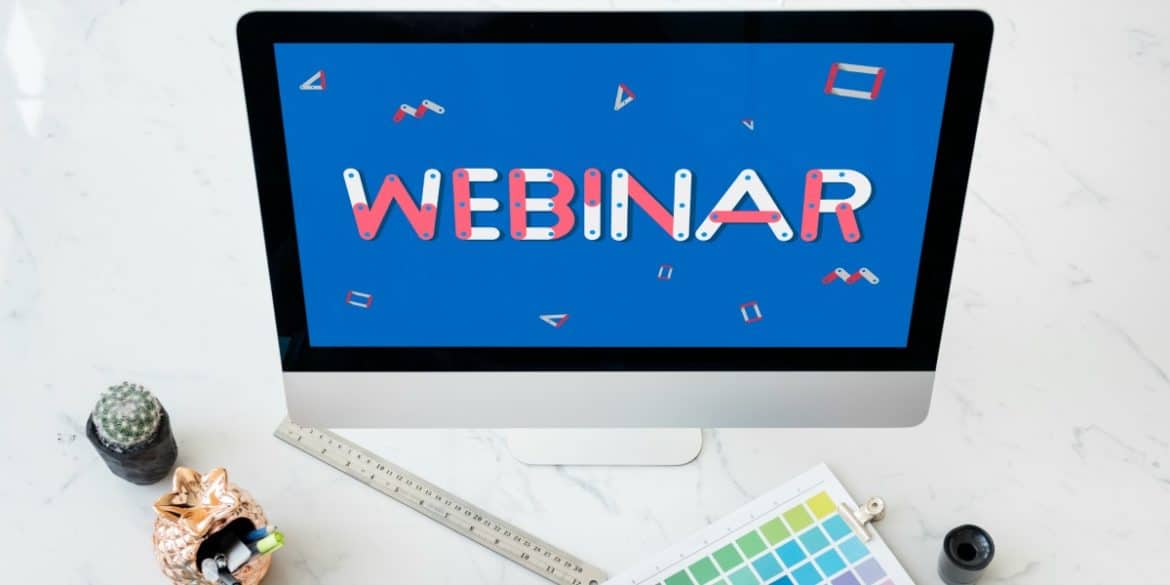Webinars are an excellent vehicle for effectively delivering information to a fragmented audience online and in real time. Regardless of where an audience member is physically based, providing they have a sufficient Internet connection they can join and be part of a webinar. This reality enables a large group of individuals to be brought together in a cohesive way to facilitate more intuitive outcomes.
You could even argue that an informal information exchange between two or more individuals via Skype or another video conferencing tool constitutes a webinar, but for the purposes of this post I will be focusing on the more formal, larger-scale webinars that are hosted throughout the world today.
In addition to enabling people to see and speak to one another over the Internet, webinars also offer a number of extra capabilities, such as screen sharing, real-time chat and co-hosting.
Some people confuse webinars with webcasts, but there’s actually a distinct difference. Webinars are exclusively attended by an online audience, whereas webcasts have both an online audience and a physical one. Webcasts are basically a way for people to still attend a seminar or training session remotely if they can’t make it in person.
Now while pretty much anyone can host a webinar providing they’ve got the right tools available, the difference between a good webinar and a kickass webinar is vast.
The good news, though, is that by following the top tips outlined below, you will stand a significantly higher chance of hosting a webinar that’s effective, intuitive and well received by all – in other words, kickass!
My immediate thought when compiling this post was to contact our own webinar partner, WebAttract, and get some input from co-founder Mike Agron. Mike’s conducted more webinars than I’ve had hot dinners, so I knew the eBook he kindly furnished me with would be worth its weight in gold. I wasn’t wrong…
In Mike’s The Art of Producing Webinars That Work eBook, there are three common webinar myths, as well as a host of other useful information.
The three myths are:
- Webinar myth #1: “If you build it, they will come.”
- Webinar myth #2: “Some speakers believe they can wing it and not rehearse. A virtual event is not the same as a live in-person one.”
- Webinar myth #3: “All attendees are sales-ready to buy now.”
I touch briefly on each of them in my top tips for hosting a kickass webinar roundup:
1. Know Your Audience
First and foremost, it’s important you know your audience before you even begin planning a webinar. After all, it’s likely that your webinar will want to address some of their biggest pain points, immediate challenges, and, ultimately, give an insight into the products and services you offer that can help.
This tip links directly to the first myth in Mike’s eBook: “All attendees are sales-ready to buy now.” However, the reality is that many aren’t. In fact, while you might close a deal following a webinar sometimes, it is more the exception than the rule.
That’s why it’s important to interact with your audience ahead of time and discover what they’d really like to learn about. At the end of the day, if you create a webinar that doesn’t automatically draw people to it – maybe because of the subject matter – it’s not going to get a lot of attention.

2. Focus On A Specific Topic/Subject Area
Your webinar needs to focus on a specific topic/subject area. That’s because you’ve only got a set amount of time in which to deliver it and having a very broad subject area will inevitably lead to you only delivering a basic overview.
A better webinar approach is to go into depth on a subject and provide the audience with a much more valuable insight. For example, instead of delivering a webinar on SEO, zoom it in to focus on a specific component, such as content marketing, social media marketing, keyword research, etc.
Remember, webinars are all about delivering value, showcasing your knowledge, and leaving your audience feeling satisfied.
3. Promote your webinar ahead of time
This tip relates to Mike’s first webinar myth: “the belief that if you build it, they will come.” As Mike points out, nothing could be further from reality.
Just because you’ve organized a webinar, why should your followers clear their schedules to make time for it? It all goes back to what’s in it for them? What value will it afford?
That’s why it’s important to promote your webinar well ahead of time. It’s no good posting a couple updates on social media the day before you’re going live. You need to be sending emails, writing blog posts and keeping your social media buzzing about your upcoming webinar.
A great way to keep the conversation relevant and in one place is to come up with a unique hashtag for your webinar. Encourage people to use it when submitting questions ahead of the event via social media or to generate discussions about your webinar.

4. Use A Script (But Don’t Be Afraid To Stray From It)
Even if you’re a confident speaker and have delivered presentations and seminars on numerous occasions, create a script for your webinar. Think of it as your compass throughout, the instrument that is going to keep you pointed in the right direction and not allow you to go off on tangents.
You see, the trouble with webinars is that it’s sometimes difficult to keep your audience’s attention throughout (tip #9 in this list looks into this a little more), so you need to stay focused. Go off on a random thought and you risk losing not only your flow, but also the ears of the people you’re trying to engage.
However, just because you’ve got a script, it doesn’t mean you have to stick to it letter by letter. You may suddenly think of a story or anecdote that will help really emphasize a point you’re making. Don’t be afraid to tell it; just ensure you get back on track again and don’t consume too much time on it.
Real-life situations and stories are a great way to add extra support to what you’re saying and will help your audience more easily relate.
5. Practice Makes Perfect
This is the first of two quick and dirty tips in this list. It’s a cliché that’s as old as the hills, but practice really does make perfect – and you want your webinar to be perfect, right?
It relates directly to Mike’s webinar myth #2: “Some speakers believe they can wing it and not rehearse. A virtual event is not the same as a live in-person one.”
By practicing what you’re going to say beforehand, you’ll reduce the chance of you having long pauses/silences, which can make your audience question their audio equipment.
6. Choose The Right Webinar Platform
As mentioned earlier, while Skype is a great tool for facilitating video calls, it’s not going to cut it when you want to deliver a professional, intuitive, seamless webinar.
The good news is that there are lots of different webinar tools out there for you to choose from. The difficult part is separating the wheat from the chaff and finding one that’s right for you.
This recent post by Growth Marketing Pro co-founder, Hailey Friedman, is a great starting point.
Factors to consider when making a decision:
- How many webinars will you host on a monthly/weekly basis?
- What is your budget?
- What support comes with the tool?
- Is the ability to record important?
- What interactive features are a must?
- What’s your primary objective?
7. Ensure Your Surroundings Are Perfect
The location from which you conduct your webinar says more about you than you might think. Don’t forget that your audience are going to be staring at their screens for a significant amount of time and they will pick out every little detail in your surroundings.
You’ll want to portray a sense of professionalism, so think about whether your surroundings do that or not. A dirty coffee cup, your lunch from earlier and a full rubbish bin are all things you don’t really want in view.
Also, make sure you are somewhere that’s quiet. If it’s your home office, ensure you’re not going to be disturbed by somebody interrupting. While it can be easy to laugh off an unplanned interruption, it could lead to you losing your train of thought and prompt some of those unwanted silences while you regain your composure.
Finally, cell phones should be switched off or put into silent mode, and your computer volume muted to prevent any unwanted notifications.

8. Be Early
This is quick and dirty tip #2, one that some people don’t even think about. But you should! Your audience has been waiting for this webinar of yours for weeks, maybe months. The least you can do is be on time – actually no, be early. Have everything ready for when people try to logon and be there to greet them with a smile and a friendly welcome.
9. Engage and Interact Throughout
Start as you mean to go on. By that I mean you should begin your webinar with something that really grabs your audience’s attention and then look to build on it. Whether that’s an amazing fact, interesting anecdote, whatever. The key is to grip your audience early on and, ideally, have them hanging on your every word.
Just remember that people’s attention spans aren’t infinite, so you should look to have short breaks wherever appropriate to allow people to rest their ears, eyes and brains. If you don’t, you run the risk of having your audience checking their Facebook accounts or sending emails while you’re speaking.
A great way to create a stronger connection is by being personable and using “you” throughout your webinar. You should also look to encourage input from your audience and don’t be afraid to be humorous.
10. Accept That Things Will Go Wrong
Problems do occur – that’s life! Even the best prepared webinar hosts encounter issues from time to time. The differentiating factor will be if you can cope with any problems that do arise professionally. Try not to lose your composure, don’t make excuses, and reassure your audience.
A webinar is a live event, the same as live TV, which means that anything can happen. Just make sure you’ve checked the basics: your laptop is charged and plugged in, you’ve got a space mic/camera in case yours gives up the ghost, and you’ve performed a thorough sound check.
You can even consider having a technical assistant on hand. They are there to ensure everything goes as smoothly as possible, something that allows you to focus on delivering the kickass webinar you’ve been working so hard on.
11. Have A Definitive And Clear CTA
Finally, you need to have a definitive call to action that you want your audience to take at the end of your webinar. Make sure it’s clear and you’ve made it as easy as possible for them. Whether that’s download an eBook or sign up to your mailing list, be sure to outline it at the end of the webinar and in your follow-up email.
If your audience doesn’t know what you want them to do, chances are they won’t do it automatically.
And now here’s my own CTA…
If you’ve got any additional tips that I’ve missed, please tweet me @JDevonshire or leave a comment below.
Also, please consider downloading Mike Agron’s The Art of Producing Webinars That Work eBook from the WebAttract website. It’s a cracking resource for people who are serious about delivering webinars that rock.
I’m a full-time freelance writer and Managing Editor at Creative Mindscape who is lucky enough to call the tropical paradise that is the Philippines my adopted home. In my spare time, I love to dabble in cryptocurrencies and play with my three young children. One’s a stressful, non-stop rollercoaster ride; the other is cryptocurrencies.




